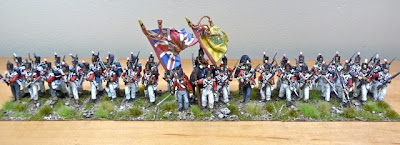(Originally posted on the Home Page, Dec 15th)
I was glancing at my blog calendar just the other day and realized that December 19th will mark a year since I started 'Analogue Hobbies'. Wow. It feels both so long ago and yet it seems like only yesterday. I must say that at the time, when I started this whole blogging thing, I was a bit leery about it, thinking my interest would quickly peter-out or I'd simply have nothing to say. Well, while I doubt that what I have to say is of any real value I have found that the blog has become very valuable to me for a variety of reasons. First and foremost is that I've met some really fabulous people through blogging - people who have a similar passion for the hobby and whose words of encouragement have been both gracious and helpful.
 |
| A bird's eye view of the two forces. |
In addition making new friends, this whole exercise has really helped me focus my efforts at the hobby table. I dunno, but it seems the mixture of getting jazzed in seeing others' great projects and knowing that there are others out there anticipating my own work has really fanned the fires of productivity.
 |
| The white-uniformed 16th advancing towards the British position. |
To underline this new 'renaissance' I've had for the hobby I thought it would be fun if I spent the next few days pulling out all the stuff I've done over the past year or so, set it up on the table and take some shots - sort of a 'Year in Review'. So, first up is the largest representative of my efforts this year, figures for 'The Beautiful Game': Napoleonics.
 |
| Rifles sending out a skirmish screen to meet the French. |
The pictures here show the majority of my French and British collection. To be clear, about five of these units had their beginnings many years ago, and a few were started about 14 months ago, but for the most part what you see is around a year's worth of work. I think there is around 550 models in total of which I probably painted approximately 400 in the past year. I'm usually a fairly plodding painter so this is a notable achievement for me especially when this does not include the oddball forays like my Dystopian Wars diversion and things like the recent Russian 'campaign'.
 |
| Marshal Ney leading forward regiments of Carabiniers and Dragoons. |
 |
| Portion of a British Rocket battery getting ready to engage. |
 |
| Imperial Guard 12 pounders doing hot work. |
 |
| A view down the French line. |
Anyway, like the picture of Ney above, I thank all the visitors of Analogue Hobbies in spurring me on - you've been a great encouragement to me in both getting stuff done and enjoying the stuff that I do. Its been a great year and I'm really looking forward to seeing what the new one will bring.
Season's Greetings and a Happy New Year!
Curt
















































